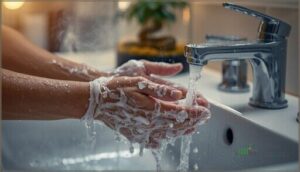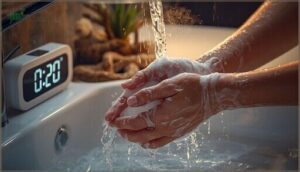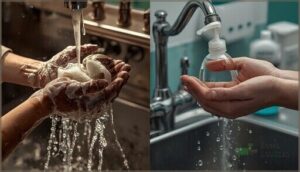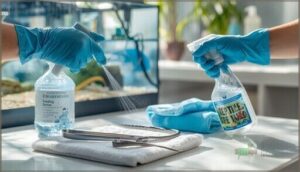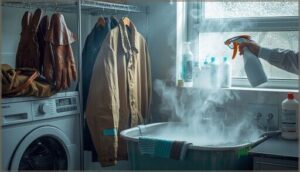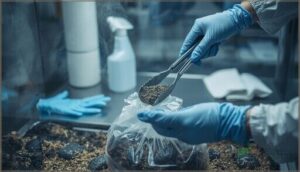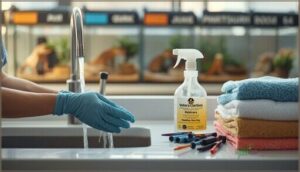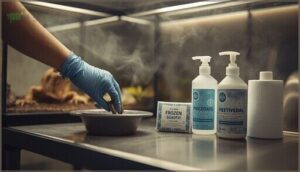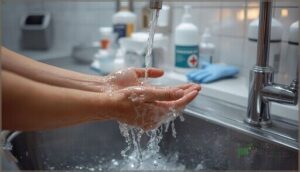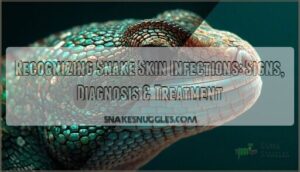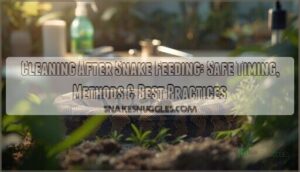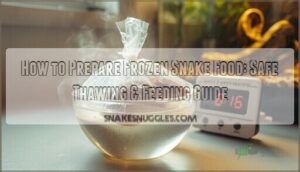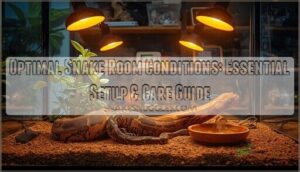This site is supported by our readers. We may earn a commission, at no cost to you, if you purchase through links.
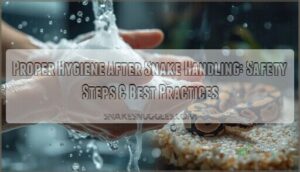
Yet many handlers skip important hygiene steps, assuming that because their snake looks clean, contamination isn’t a concern. That assumption creates the exact conditions for zoonotic disease transmission.
Proper hygiene after snake handling doesn’t require elaborate protocols, but it does demand consistency. The difference between safe and risky handling often comes down to a few critical practices performed correctly every single time.
Table Of Contents
- Key Takeaways
- Why Hygiene Matters After Snake Handling
- Essential Handwashing Techniques
- Cleaning Tools and Surfaces Post-Handling
- Clothing and Personal Protective Gear Care
- Safe Waste Removal and Disposal
- Preventing Disease Spread in Multi-Snake Homes
- Managing Feeding and Cleaning Hygiene
- Monitoring for Infection or Illness
- Emergency Procedures After Potential Exposure
- Advanced Hygiene for Snake Handlers
- Frequently Asked Questions (FAQs)
- Conclusion
Key Takeaways
- Over half of captive snakes carry Salmonella bacteria, requiring 20-second handwashing with soap and water after every handling session to remove up to 99.9% of pathogens—hand sanitizer doesn’t work as effectively for this purpose.
- All tools, surfaces, and protective gear need disinfection with reptile-safe products like chlorhexidine or F10SC between handling sessions, especially in multi-snake homes where cross-contamination can spread disease rapidly.
- Snake waste contains Salmonella that survives up to 30 months, making immediate double-bagging of feces and proper disposal of contaminated substrate critical for preventing household and wildlife exposure.
- New or sick snakes require 90-day minimum quarantine with dedicated equipment and separate handling protocols, while children under five face particularly serious infection risks and need supervised hygiene enforcement.
Why Hygiene Matters After Snake Handling
Handling snakes isn’t just about technique—it’s about understanding the invisible risks that come with every interaction. Even healthy-looking snakes can carry bacteria and pathogens that pose real threats to you and your household.
Let’s examine why proper hygiene after handling isn’t optional, it’s essential.
Risks of Salmonella Transmission
Among all reptiles, snakes carry Salmonella bacteria at the highest rate—around 56%. Even healthy-looking snakes can shed this pathogen through feces, skin contact, and contaminated tank water. Direct handling or touching contaminated surfaces creates multiple transmission pathways that put you at risk for serious bacterial infections.
Snakes carry Salmonella at the highest rate among reptiles—56%—and shed it through feces, skin, and water, creating real infection risks
Human health impacts you need to know:
- Infection statistics are sobering: Roughly 74,000 Americans contract Salmonella from reptiles annually, with children under five especially vulnerable.
- Risk factors multiply quickly: Stress, poor husbandry, and infected feeder rodents increase bacterial shedding in captive snakes.
- Prevention measures work: Thorough handwashing and proper hygiene dramatically reduce your chances of contracting zoonotic diseases.
A recent outbreak showed exposure to rodents was a likely source.
Zoonotic Diseases From Snakes
Salmonella transmission isn’t your only concern. Zoonotic diseases from snakes include pentastomiasis risks—liver parasites found in up to 40% of humans in snake-consuming regions. Clinical manifestations range from asymptomatic calcifications to severe organ dysfunction.
Disease outbreaks tied to reptiles cause 74,000 bacterial infections yearly in the U.S. alone. Transmission can occur through reptilian zoonoses, highlighting the risk of direct contact.
Preventive measures start with rigorous hand washing and recognizing that every snake contact carries potential health consequences.
Protecting Human and Snake Health
Your hygiene practices directly influence both your health and your snake’s well-being. Rigorous hand washing after every handling session cuts zoonotic disease risks by at least 50%.
Safe handling practices paired with proper infection risk reduction protocols prevent cross-contamination between enclosures.
Disease transmission prevention starts with consistent hygiene protocol impact—regular disinfection lowers illness rates in captive snakes while protecting you from Salmonella bacteria exposure.
Essential Handwashing Techniques
Washing your hands after handling a snake isn’t something you can rush or skip. The technique you use directly affects how well you remove harmful bacteria like Salmonella, which lives on over half of all snakes.
Let’s break down the specific steps that make handwashing effective and explore when soap and water beats hand sanitizer.
Proper Soap and Water Use
When you handle snakes, soap isn’t just a courtesy—it’s your first line of defense. Plain or antibacterial soap paired with warm water (77–100°F) removes over 99% of Salmonella bacteria from your skin, dramatically outperforming hand sanitizer for snake handling safety. Wash hands immediately after contact to prevent Salmonella infection:
- Lather all surfaces: palms, backs, between fingers, under nails
- Use warm water for 30% better pathogen removal
- Air-dry or use clean towels to avoid recontamination
Duration and Method for Best Results
When you’re ready to wash after handling your snake, commit to a full 20 seconds of vigorous scrubbing—this duration removes up to 99.9% of Salmonella bacteria. Focus your technique on interlacing fingers, cleaning under nails, and covering wrists. Water temperature between 77–100°F enhances pathogen removal.
Air-dry or use clean towels to prevent recontamination, reinforcing proper hygiene and preventing Salmonella infection through consistent compliance monitoring.
Hand Sanitizer Vs. Soap for Snake Handling
While hand sanitizer offers convenience, soap and water consistently outperform it in pathogen removal during safe snake handling. Public recommendations from the CDC prioritize soap superiority for preventing Salmonella infection due to practical limitations of sanitizers with visible contamination.
- Soap removes up to 99.98% of bacteria effectively
- Sanitizer effectiveness requires at least 60% alcohol content
- Visible dirt compromises hand sanitizer performance completely
- Soap maintains hygiene standards under all conditions
- Safe handling protocols mandate soap as primary defense
Cleaning Tools and Surfaces Post-Handling
After you’ve handled your snake, don’t stop at washing your hands. Every tool, surface, and accessory that came into contact with your snake needs proper disinfection to prevent bacterial spread.
Here’s how to clean your equipment and workspace safely.
Disinfecting Snake Hooks and Tongs
Your snake handling tools can harbor dangerous pathogens between sessions. Wash hooks and tongs with warm, soapy water first—this removes debris before disinfecting surfaces.
Soak tools in chlorhexidine (1:30 dilution) or 5–10% bleach for at least five minutes to guarantee disinfectant efficacy. Rinse thoroughly to eliminate residue and air-dry completely.
Check material compatibility; stainless steel resists chemicals better than plastic. Use dedicated tools for sick snakes to prevent cross-contamination between animals.
Cleaning Work Surfaces and Accessories
Your work area is often the silent carrier of pathogens after each snake session. Weekly cleaning reduces bacterial growth by over 90% when you follow proper protocols:
- Scrub surfaces thoroughly before applying any disinfectant—debris blocks disinfectant efficacy on contact
- Apply reptile-safe disinfectants like F10SC or chlorhexidine at safe dilution ratios (1:30-1:40)
- Allow 10-minute contact time for complete pathogen elimination, then rinse completely to guarantee residue removal
This clean environment prevents mold growth and protects both you and your animals.
Safe Disposal of Used Cleaning Materials
Tossing contaminated materials in your kitchen trash? That’s a public health hazard waiting to happen. Disposable gloves and cleaning wipes from your snake enclosure count as biohazard waste—seal them in plastic bags before landfill disposal.
PPE disposal demands care: never compost used items. For liquid disinfectant, pour it down the sewer, not storm drains.
Worker safety and reptile hygiene depend on proper protocols that protect your clean environment.
Clothing and Personal Protective Gear Care
Your protective gear doesn’t clean itself, and neglecting it can turn your gloves and clothing into bacterial breeding grounds. Proper care isn’t just about extending the life of your equipment—it’s about preventing the spread of pathogens between handling sessions.
Let’s cover the essential steps to keep your gear clean, safe, and ready for your next interaction with your snakes.
Washing Gloves and Protective Clothing
Your protective clothing and gloves aren’t truly clean until they’ve been properly washed and disinfected. Reusable glove washing requires hot water at least 140°F, combined with detergent, to inactivate pathogens effectively. After each handling session, dedicate washing facilities specifically for reptile hygiene—never mix this gear with household laundry. Disinfectant contact time must reach 10 minutes minimum for thorough decontamination.
Safe handling starts with proper hygiene practices:
- Wash protective clothing in hot water with soap or disinfectant solution
- Apply isopropyl alcohol, dilute bleach, or chlorhexidine to equipment surfaces
- Rinse powder-free gloves thoroughly before disposal to reduce contamination
- Launder cloth holding bags separately with bleach soak between uses
- Air-dry all gear completely before storing to prevent bacterial growth
Single-use disposable gloves remain the best option—nitrile and vinyl materials demonstrate greater pathogen reduction compared to latex. If you must reuse gloves, understand that glove material efficacy drops considerably after handling three to four animals, even with disinfectant application between individuals.
When to Change or Replace Gear
Even the best hygiene practices can’t fix compromised gear. Heavy-duty gloves demand immediate replacement if punctured or torn, since compromised glove integrity increases bite risk and zoonotic transmission.
Check for tool corrosion on metal hooks monthly—rust weakens joints and creates safety hazards. Grip condition matters too; worn foam reduces control during snake handling.
Dispose of contaminated single-use items in biohazard disposal containers, following safety standards that protect both you and your animals.
Preventing Cross-Contamination
Separating clean and dirty gear starts before you touch your first snake. Facility hygiene protocols demand storage systems that keep fresh gloves isolated from used equipment—mixing these increases contamination source control failures by 16%.
Here’s how reducing zoonotic risk works in practice when handling multiple snakes:
- Designate separate containers for clean versus soiled protective gear
- Apply hand sanitizer between animals if soap isn’t immediately accessible
- Change gloves completely before moving to the next enclosure
- Keep disinfectant spray bottles at each handling station for quick tool cleaning
- Establish safe transport practices that prevent gear from touching contaminated surfaces
These hygiene practices form your foundation for disease prevention during safe snake handling sessions.
Safe Waste Removal and Disposal
Waste removal isn’t glamorous, but it’s one of the most critical steps in preventing disease transmission. Snake feces and soiled substrate can harbor Salmonella and other pathogens that pose real health risks to both you and your animals.
Here’s how to handle, dispose of, and clean up after waste safely and effectively.
Handling Snake Feces Safely
When dealing with snake feces, you’re facing a genuine health risk. Salmonella can survive in reptile waste for up to 30 months, so protective gear isn’t optional. Always wear disposable gloves during waste removal, and use paper towels or plastic bags as barriers. Seal solid waste immediately in dedicated trash bags. These disinfection protocols and waste containment practices form the foundation of safe snake handling hygiene and effective health monitoring.
| Step | Method | Purpose |
|---|---|---|
| Pick up feces | Use gloved hands or disposable tool | Prevent direct bacterial contact |
| Seal waste | Place in dedicated trash bag immediately | Contain pathogens and odor |
| Clean area | Apply 10% bleach solution for 10-15 minutes | Eliminate Salmonella and parasites |
Proper Disposal of Used Substrate
Once you’ve contained the waste, turning your attention to used substrate protects both your household and local wildlife. Contaminated bedding harbors pathogens like Ophidiomyces ophiodiicola, which can persist and spread disease.
Follow these disposal regulations for safe snake waste removal:
- Double-bag non-biodegradable substrate in heavy-duty garbage bags for landfill disposal
- Compost uncontaminated biodegradable options separately from garden materials
- Never dispose substrate outdoors where environmental impact could introduce fungal diseases to native species
Substrate replacement reduces substrate pathogen risk considerably.
Cleaning Waste Removal Tools
After handling waste, your tools need decontamination—not just a rinse. Soak removal implements in a 1% potassium peroxymonosulfate solution for five minutes to neutralize pathogens like Salmonella. Tool Disinfection Protocols demand Equipment Segregation: never use these items for household tasks.
| Protocol | Method | Frequency |
|---|---|---|
| Spot cleaning | Remove visible debris | Daily |
| Chemical disinfection | Soak in disinfectant solution | Every 2-4 weeks |
| Mechanical scrubbing | Brush adherent material | Weekly |
| Steam sterilization | Boil metal implements | Monthly |
| Tool replacement | Discard worn brushes/sponges | Monthly minimum |
Cleaning Frequency should include daily spot-cleaning and full decontamination every two to four weeks. Wear disposable gloves during each session—Protective Measures reduce hand contamination by over 70%.
Using Reptile-Safe Disinfectants like chlorhexidine-based products ensures broad-spectrum microbial reduction without harsh residues. Disinfecting Surfaces extends to your dedicated cleaning basin, never a household sink.
Post-Cleaning Storage requires complete drying to prevent bacterial persistence. Store tools in clean, dry areas away from substrate. Proper snake hygiene practices include documenting your cleaning routines in a care log. Snake waste removal demands vigilance: replace damaged implements immediately to maintain effectiveness. Cleaning snake enclosures becomes safer when your tools themselves remain pathogen-free.
Preventing Disease Spread in Multi-Snake Homes
When you keep multiple snakes, disease can move between animals faster than you might expect. Each handling session becomes a potential transfer point for bacteria, parasites, and viruses if you’re not careful with your protocols.
Let’s walk through three critical steps that’ll help you maintain a healthy collection and prevent cross-contamination between your animals.
Quarantining New or Sick Snakes
Think of quarantine as your first line of defense against bacterial growth and disease prevention—it’s non-negotiable when protecting your collection. Isolation protocols require separating new or sick snakes for 90 days minimum, though many professionals recommend 3–6 months.
Here’s your quarantine checklist:
- Facility setup: Use a separate room with dedicated equipment for each snake
- Veterinary exams: Schedule fecal screenings and parasite treatments immediately
- Biosecurity measures: Change gloves between animals and maintain detailed health records daily
Ideal snake hygiene starts before introduction, not after.
Disinfecting Between Handling Sessions
After you work with one snake, you’ll need to disinfect all tools and surfaces before touching another—this prevents cross-contamination and disease prevention in your collection. Apply a 0.15% bleach solution or reptile-safe disinfectant, allowing 10–15 minutes of contact time for proper pathogen inactivation. Then rinse thoroughly and air dry.
Routine frequency matters: disinfect between every handling session, change gloves each time, and prepare fresh solutions daily for effective hygiene practices and safe handling.
Monitoring for Signs of Illness
You’ll notice symptoms in yourself within 12–72 hours if exposed to salmonella—diarrhea, fever, and abdominal pain signal human symptom onset.
In your snakes, check for scale conditions daily: scabs, discolored patches, or facial swelling indicate trouble. Breathing patterns matter too—wheezing or open-mouth respiration demands attention.
Captive populations shed bacteria at 56%, making snake health monitoring and quarantine protocols essential for disease prevention in multi-snake collections.
Managing Feeding and Cleaning Hygiene
Feeding time and routine cleaning create some of the highest-risk moments for bacterial exposure in snake care. Frozen rodents, leftover prey items, and soiled dishes all harbor pathogens that require immediate attention.
Here’s how to manage these tasks while protecting both your health and your snake’s wellbeing.
Hygiene After Handling Feeders
Thawing feeders introduces serious bacterial growth risks. You should always use separate zones for feeder storage and preparation, never sharing equipment with your kitchen.
Disinfect equipment immediately after handling frozen or live prey using reptile-safe disinfectants. Wear protective gear during feeder handling and wash your hands for at least 20 seconds afterward.
Proper snake hygiene practices during safe handling sessions protect both you and your snake from cross-contamination.
Cleaning Food and Water Dishes
Your snake’s food and water dishes harbor millions of bacteria within 48 hours, making weekly cleaning critical for ideal snake hygiene. Wash dishes in a dedicated basin—never your household sink—using Dawn soap or reptile-safe disinfectants like F10 to prevent cross-contamination risks.
- Scrub dishes thoroughly and rinse all residue before returning them to the enclosure
- Dispose of wastewater in toilets, not down household drains
- Disinfect your cleaning environment after each session to control bacterial growth
Proper snake hygiene practices protect both you and your reptile from disease transmission.
Safe Handling of Leftover Food
Leftover feeder rodents left at room temperature for over 30 minutes can transmit foodborne pathogens and spark bacterial growth, so discard them immediately.
Safe thawing practices require refrigeration at 40°F or below; never refreeze thawed feeders.
Keep disposal methods simple: seal uneaten food in bags before trashing to prevent cross-contamination risks.
Storage protocols demand separate spaces for reptile and human food, protecting your snake health and your own.
Monitoring for Infection or Illness
Even with careful hygiene practices, infections can still occur in both you and your snake. Recognizing symptoms early makes a significant difference in treatment outcomes and recovery time.
Let’s examine the warning signs to watch for in yourself, your snake, and when professional help becomes necessary.
Recognizing Early Signs in Humans
Because snake-related infections don’t always announce themselves loudly, you need to watch for subtle warning signs. Salmonella symptoms like diarrhea, fever, and abdominal pain generally surface 12–72 hours after contact. Check your bite site for swelling, warmth, or redness within 24–48 hours.
Systemic symptoms—nausea, weakness, chest tightness—can emerge quickly. Neurological signs and psychological impact, though rarer, demand immediate first aid and snake bite treatment.
Monitoring Your Snake’s Health
While you’re watching for your own symptoms, your snake deserves equal attention. Observing scale conditions reveals problems early—look for dullness, lesions, or shedding issues. Checking breathing patterns catches respiratory trouble before wheezing starts.
Tracking feeding responses and conducting bi-weekly weight checks support snake health monitoring. Any sudden change—loss of appetite, odd posture, cloudy eyes between sheds—signals it’s time for a closer look.
When to Seek Medical Advice
If your snake seems off, trust your gut—but know when your own health demands professional input. Bite symptoms like spreading redness, severe pain, or swelling warrant immediate medical attention. Infection signs—fever, persistent diarrhea, or odd wound changes—require evaluation, especially after zoonotic exposure. Systemic reactions don’t wait.
Contact a healthcare provider if you experience:
- Shortness of breath, chest pain, or confusion post-bite
- Gastroenteritis symptoms lasting over three days after handling
- Rapidly spreading erythema or warmth around wounds
- Headache, lymphangitis, or persistent fever within 48 hours
- Any snake bite, even minor—100% require assessment for potential venom
Snake bite prevention starts with caution, but snake bite treatment and veterinary help shouldn’t be delayed when warning signs appear.
Emergency Procedures After Potential Exposure
Even with careful handling, accidents happen—bites, scratches, or contact with open wounds can expose you to bacteria or other pathogens. How you respond in those first few minutes can make a real difference in preventing infection or complications.
Here’s what you need to do immediately after potential exposure.
What to Do if Bitten
Every snake bite is a medical emergency. Call 911 immediately, remove jewelry near the bite site, and keep the bitten limb below heart level. Don’t apply ice, tourniquets, or attempt to suck out venom. Mark swelling edges with a pen and record the time. Antivenom access and hospital treatment within six hours reduces mortality risk by up to 82%.
| Do This Immediately | Never Do This |
|---|---|
| Call 911 and record time | Apply ice or tourniquet |
| Remove constricting items | Cut wound or suck venom |
| Keep limb below heart | Give aspirin or alcohol |
| Mark swelling progression | Capture or kill the snake |
Steps After Contact With Open Wounds
If you have an open wound and handle snakes, bacterial infection risk jumps to 77%.
Flush it immediately with warmed saline using a 10–20 mL syringe, then apply chlorhexidine or dilute iodine—both reduce bacteria by 85%.
Cover with a waterproof bandage and change it daily. Watch for redness, swelling, pus, or foul odor. These infection warning signs demand quick action.
Contacting Medical Professionals
Even with skilled first aid limitations, professional snake bite treatment saves lives. Only 41% of bite victims actually call for help, yet antivenom availability and post-bite monitoring drastically improve outcomes.
Contact medical professionals immediately if:
- Bite severity assessment reveals swelling, pain, or discoloration spreading beyond the bite site
- Neuroparalytic or hemorrhagic symptoms emerge within the first hour
- Telemedicine options or your emergency plan for snake bites indicate specialist veterinary consultation is needed
Advanced Hygiene for Snake Handlers
Once you’ve mastered the basics of post-handling hygiene, it’s time to raise the bar. Sophisticated practices separate casual handlers from those who maintain truly safe, disease-free environments.
Let’s look at three key areas that’ll keep both you and your snakes healthier in the long run.
Using Reptile-Safe Disinfectants
You can’t afford to choose the wrong disinfectant—residue concerns and bacterial growth make product selection critical. Safe disinfectant types like chlorhexidine or F10SC are your best options for using reptile-safe disinfectants.
Follow dilution best practices precisely, allow proper contact time (at least two minutes), and rinse thoroughly. Elevated hygiene techniques demand careful storage and disposal practices to maintain snake safety without compromising effectiveness.
Regular Deep Cleaning Schedules
Your snake enclosure doesn’t need constant overhaul—but timing matters. Deep cleaning every one to three months strikes the right balance, though cleaning frequency adjusts based on substrate types and waste output. Multi-snake setups demand closer attention.
- Spot-clean daily to minimize bacterial buildup between deep cleans
- Replace substrate entirely during each thorough cleaning session
- Bioactive enclosures may extend intervals to six months or longer
Using reptile-safe disinfectants with proper contact time ensures pathogen removal without harming your animals.
Continuing Education and Best Practices
Staying current on safe snake handling techniques separates casual keepers from true professionals. Updated protocols, biosecurity measures, and handling innovations evolve as pathogen research advances, so continuing education sharpens your zoonotic prevention skills and emergency response readiness.
| Training Type | Focus Areas |
|---|---|
| Certification Courses | Snake handling precautions, venom toxinology, emergency care |
| Veterinary Programs | Snake health and safety, disease monitoring, medical treatment |
| Outreach Workshops | Snake safety guidelines, preventing accidents with snakes, public education |
Regional programs offer hands-on training with live snakes, covering everything from hook techniques to bite management protocols.
Frequently Asked Questions (FAQs)
Can snakes transmit parasites to other household pets?
While many assume reptile parasites stay within their species, snakes can transmit Cryptosporidium, Salmonella, and mites to dogs and cats through fecal contamination or shared surfaces, making pet health impacts a genuine concern.
How often should snake handling areas be disinfected?
At minimum, disinfect weekly using reptile-safe disinfectants like F10 or chlorhexidine. Daily waste removal prevents Salmonella risk.
Increase cleaning protocols for venomous snakes, outbreak control, or sick animals.
Monthly deep cleaning maintains ideal enclosure conditions.
Are there hygiene risks from snake shed skin?
An ounce of prevention is worth a pound of cure.” Shed skin pathogens like Salmonella and fungal disease spread pose real risks.
Always use gloves during handling protocols to prevent snake skin infections and environmental impact from heavy metal contamination.
What cleaning products are unsafe around snake habitats?
Toxic disinfectants like bleach, ammonia-based cleaners, and phenol-containing products pose serious fume dangers to snakes due to their chemical sensitivity.
Safe alternatives include ReptileSafe disinfectants, specifically designed for enclosure cleaning without harmful residue risks.
Should children follow different hygiene protocols after handling?
Yes, children under five face higher infection risks due to developing child immune systems. They require supervised handwashing with age-appropriate disinfectants, plus parental responsibility ensuring they avoid face-touching after any snake handling or safe interactions.
Conclusion
Keeping everyone safe doesn’t require perfect conditions—just consistent discipline. Your snake won’t mind the extra care, and you’ll protect the vulnerable people in your household from unnecessary risk.
Proper hygiene after snake handling becomes second nature once you establish the routine, but it never becomes optional.
Every handling session is an opportunity to either maintain biosecurity or compromise it. The choice is yours, and the stakes remain high regardless of how routine the interaction feels.
- https://animalcare.illinois.edu/standards/handwashing-techniques
- https://pmc.ncbi.nlm.nih.gov/articles/PMC10562597/
- https://assets.srhd.org/assets/media/documents/feeder-rodent-salmonella-8x11_5081.pdf
- https://wwwnc.cdc.gov/eid/article/31/10/24-1803_article
- https://www.nature.com/articles/s42003-024-06092-x

